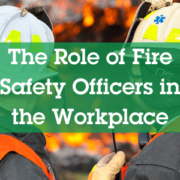Role of Safety Managers in the Workplace
In modern workplaces, health and safety are paramount. At the forefront of this critical mission are Safety Managers a role in which individuals entrusted with the responsibility of creating a secure and healthy work environment. This blog looks at the significance of Safety Managers in the workplace, outlining their expectations, daily responsibilities, and the invaluable ways in which they lead health and safety initiatives.
Expectations of the Safety Managers Role
Safety Managers bear the crucial responsibility of leading health and safety within the workplace. Key expectations include:
Regulatory Compliance:
- Ensuring adherence to health and safety regulations mandated by law.
- Staying updated on regulatory changes and implementing necessary adjustments.
Risk Assessment and Mitigation:
- Conducting regular risk assessments to identify potential hazards.
- Implementing effective control measures to mitigate identified risks.
Training and Education:
- Providing comprehensive safety training for employees at all levels.
- Ensuring that all staff are well-versed in emergency response protocols.
Incident Investigation:
- Conducting thorough investigations into workplace incidents.
- Implementing corrective measures to prevent the recurrence of accidents.
Policy Development:
- Formulating and updating health and safety policies tailored to the organisation’s needs.
- Communicating policies clearly to all employees.
Daily Responsibilities
The daily routine of someone with a Safety Managers role is varied, involving a range of responsibilities such as:
Morning Briefings:
- Conducting daily safety briefings to reinforce the importance of safety.
- Addressing any emerging safety concerns and leading a proactive safety mindset.
Site Inspections:
- Regularly inspecting workplace facilities to identify potential hazards.
- Collaborating with teams to address immediate safety issues.
Training Sessions:
- Organising and conducting safety training sessions for new and existing employees.
- Tailoring training programs to address specific risks associated with different roles.
Documentation:
- Maintaining detailed records of safety inspections, incidents, and training sessions.
- Using data to assess the effectiveness of safety programs and identify areas for improvement.
Collaboration:
- Working closely with management, department heads, and employees to integrate safety considerations into daily operations.
- Providing guidance on the selection and use of safety equipment.
Leading Health and Safety Initiatives
- Safety Managers play a pivotal role in leading health and safety initiatives, benefiting the workplace in several ways:
Risk Reduction:
- Proactively identifying and mitigating potential risks reduces the likelihood of workplace accidents and injuries.
Legal Compliance:
- Ensuring compliance with health and safety regulations protects the organisation from legal consequences, including fines.
Employee Well-being:
- Creating a safe work environment contributes to the physical and mental well-being of employees, enhancing morale and job satisfaction.
Productivity and Efficiency:
- A safe workplace minimizes disruptions caused by accidents, leading to increased productivity and operational efficiency.
Cost Savings:
- Prevention of accidents and injuries results in cost savings related to medical expenses, workers’ compensation, and potential legal fees.
An overview of a Safety Manager Roles
Safety Managers are instrumental leaders in the ongoing quest for workplace safety. Their role goes beyond compliance; they are the architects of a secure, healthy, and productive work environment. By embracing their responsibilities with dedication and expertise, Safety Managers not only protect the well-being of employees but also contribute to the long-term success and sustainability of the organisations they serve. They are the leaders of health and safety, shaping a safer and more prosperous future for workplaces around the world.








Leave a Reply
Want to join the discussion?Feel free to contribute!